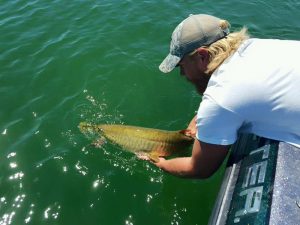Spring is the time for big fish, and big fish have been coming up in good numbers throughout the last few seasons, thanks to increased practice of catch and release by conservation-minded anglers looking to continue the opportunities for trophy-sized fish and sustainable fisheries. In fact, Minnesota has recently expanded a number of catch-and-release only seasons for bass and trout, and the success of North Dakota’s continuous fishing season is sustained by responsible catch-and-release angling, particularly now in the pre-spawn and upcoming spawning seasons. This spring, follow these tips designed to decrease the mortality of released fish, and let those great memories swim away to be caught again another day.
Artificial Intelligence. While live bait is a surefire way of catching fish, artificial lures are often less damaging to fish, aren’t taken as deeply, and are usually easier to remove. This is so due to the fact that fish will typically inhale a baitfish or crawler as if it were a wild piece of prey, and an angler’s hookset is not usually as immediate as when a fish strikes a jig, soft plastic or crankbait. If using live bait rigs for walleyes while practicing catch and release, monitor bobbers or feel for that first bite and react quickly to prevent gill- or gut-hooking of fish you plan to return to the water. Trade a small jig or a long-shanked Aberdeen hook for a standard hook when fishing crappies or bluegills you plan to release.
Count Down. Fewer hooks mean less damage to fish. Some stretches of trout waters require single-hooked lures, and anglers often replace the standard trebles on Mepps or Worden’s in-line spinners with a single hook, as trout are more sensitive to handling and unhooking activities. If you’ve ever hooked a pike with a three-trebled stickbait like a Rapala Husky Jerk, you know the nightmare of wrestling a slimy, twisting fish free of all three hooks and whatever they might tangle in. In the end, fewer hooks also means less work boatside or in the net for you.
Hook Mods. Modifying the hooks you use can reduce stress on fish and help with a clean release. When fishing live bait rigs, particularly for catfish, sturgeon and walleye, try using circle hooks. These hooks are designed with a bent-in point and a rounded shaft which slides out of a fish’s throat and connects most often in the corner of the mouth. Remember to keep constant tension while reeling in to maintain a solid connection. For quick releases of trout or panfish, consider barbless hooks, or mashing the barb down on flies or jigs. The hook slides out cleaner and requires less twisting from a pliers to get it loose.
Landing Party. When landing a fish, a rubber or rubber-coated net will be less abrasive on its protective slime coat. When fishing with a buddy, have a landing net stowed in a readily-accessible place and lay it flat a few inches below the surface and have your friend slide the fish over the net – don’t swing or jab it at the fish – for a cleaner, more successful and lower-stress landing. If possible, handle the fish with wetted hands in the water or in the net at boatside before letting it go.
Tools of the Trade. Have a pliers or forceps handy to help get tightly-stuck hooks out of fish you plan to catch and release; gently turn hooks when they are stuck tight and avoid reefing on them to prevent unnecessary injury. For bigger fish like pike or muskies, a hook-cutter is a necessity when clipping portions of treble hooks makes more sense and will cause less stress. The fish’s body and other natural processes will work the fragment out over time.
Hands On. Gently handle fish when taking a quick photo or returning them to the water. Try to keep fingers and hands wet to prevent abrasion to the fish’s slime coat and avoid touching its gills or eyes to prevent damage to these sensitive areas. Only keep the fish out of the water as long as necessary, and avoid dropping them on the floor of the boat or on shore. A good guideline for upper-limit out of water time is 45 seconds (or about the time you can hold your breath underwater) as a maximum. Carefully set the fish in the water and cradle its midsection or hold it slightly in front of the tail while it revives and shows signs of being ready to swim off. Never throw or drop a fish back into the water when releasing it.
Follow these suggestions to help facilitate a successful release of all the big fish you plan to put back this season and in the future. By doing so you’ll ensure the opportunity for other anglers down the road, a sustainable fishery for years to come, and that you’ll have the chance to hook up again…in our outdoors
